Breathing: On Counting Breaths
by Karla Beatty
Breathing, the conscious breath, is the focus of most meditation practices.
Here are insights and thoughts of spiritual leaders and teachers
on counting breaths while meditating.
Here are insights and thoughts of spiritual leaders and teachers
on counting breaths while meditating.
|
|
Breath Counting in Meditation --by Karla Beatty
Breath counting is a deceptively simple breathing technique much used in meditation practice. Sit in a comfortable position with the spine straight and head inclined slightly forward. Gently close your eyes and take a few deep breaths. Then let the breath come naturally without trying to influence it. Ideally it will be quiet and slow, but depth and rhythm may vary. Here are insights on counting breaths from Thich Nhat Hanh, Shunryu Suzuki Roshi, Josho Pat Phelan, Pema Chodron, Deepak Chopra, and Dr. Andrew Weil.

Thich Nhat Hanh
Making your breath calm and even is called the method of following one’s breath. At first breathe normally, gradually letting your breathing slow down until it is quiet, even, and the lengths of the breaths are fairly long. From the moment you sit down to the moment your breathing has become deep and silent, be conscious of everything that is happening in yourself. If it seems hard at first, you can substitute the method of counting your breath. As you breathe in, count 1 in your mind, and as you breathe out, count 2. Continue through 10, then return to 1 again. This counting is like a string that attaches your mindfulness to your breath. This exercise is the beginning point in the process of becoming continuously conscious of your breath. Without mindfulness, however, you will quickly lose count. When the count is lost, simply return to 1 and keep trying until you can keep the count correctly. Once you can truly focus your attention on the counts, you have reached the point at which you can begin to abandon the counting method and begin to concentrate solely on the breath itself. 
Shunryu Suzuki
If you just follow your breathing, then naturally, your breathing will be good, appropriate for your practice. Don’t make too much effort in making your breathing slow down or in making it faster or anything like that. Even though you don’t try to make it slower, when your breathing is fast—too fast, following breathing is good. The breathing will be slowed down. When you find it difficult to follow your breathing, counting breaths may help you. Here is the basic practice:

Josho Pat Phelan
Counting the breath is one way to practice bringing the mind to the breath. This is done by placing a count on each exhalation until you reach "ten," and then on your next exhalation, begin again with "one." While counting be careful not to interfere with the natural pace and shape of your breath. Your breath should lead the counting the same way it leads your feet in kinhin. If you practice counting your breath, sooner or later you will find that you will be able to maintain counting while your attention is elsewhere. If you are counting and find that you have gone beyond "ten"; if you suddenly notice that you are on "eighteen" or "thirty-five," stop counting, and with your next exhalation begin again with "one." The same is true when you notice that you are thinking, start counting again with "one." For years Suzuki Roshi emphasized counting the breath: the first exhalation, “one,” the next exhalation, “two,” and so forth up to ten. If you got to ten—or you lost count—you were to start again at one. Again and again Roshi reminded us that this was not about counting, but a way to help us bring the thinking mind onto the breath in the abdomen, and to encourage us to tend or take care of our breath. In one lecture, for instance, he mentioned having a feeling of kindness for your breath: “If we do not have some warm, big satisfaction in our practice, that is not true practice. Even though you sit, trying to have the right posture and counting your breath, it may still be lifeless zazen, because you are just following instructions. You are not kind enough with yourself. Be very kind with your breathing, one breath after another.” 
Pema Chodron
Our habits are strong, so a certain discipline is required to step outside our cocoon and receive the magic of our surroundings. Pause practice—taking three conscious breaths at any moment when we notice that we are stuck—is a simple but powerful practice that each of us can do at any given moment. Pause practice can transform each day of your life. It creates an open doorway to the sacredness of the place in which you find yourself. The vastness, stillness, and magic of the place will dawn upon you, if you let your mind relax and drop for just a few breaths the story line you are working so hard to maintain. If you pause just long enough, you can reconnect with exactly where you are, with the immediacy of your experience. When you are waking up in the morning and you aren’t even out of bed yet, even if you are running late, you could just look out and drop the story line and take three conscious breaths. Just be where you are! When you are washing up, or making your coffee or tea, or brushing your teeth, just create a gap in your discursive mind. Take three conscious breaths. Just pause. Let it be a contrast to being all caught up. Let it be like popping a bubble. Let it be just a moment in time, and then go on. 
Deepak Chopra
Take a breathing break to take the pressure off. Observe your breath where you are, at your desk or anywhere. Start by consciously breathing in to the count of four and breathing out to the count of six, with a short pause in between. The normal breathing rate is about 14 breaths per minute, but if you follow this simple practice, you actually decrease your breathing to somewhere between eight to 10 breaths per minute. Doing so has a very direct positive effect on your biggest nerve, the sciatic nerve, which is your stress-reliever and what brings about cell regulation.” 
Dr. Andrew Weil
The 4-7-8 (or Relaxing Breath) Exercise is utterly simple, takes almost no time, requires no equipment and can be done anywhere. Although you can do the exercise in any position, sit with your back straight while learning the exercise. Place the tip of your tongue against the ridge of tissue just behind your upper front teeth, and keep it there through the entire exercise. You will be exhaling through your mouth around your tongue; try pursing your lips slightly if this seems awkward.
For some people, counting breaths can be very helpful to help settle the mind and develop concentration. It serves as feedback to let you know that your mind has drifted. This method can be used for the entire meditation session or just for the first part of the sitting, until the mind calms a bit.
Even if you only notice 2 breaths in a row, just by coming back and starting again, you are accomplishing the practice. Sometimes our attention can drift and we might not notice until we have counted up to 20 or 30! It doesn’t matter, back to 'one'. |
|
|
Breath Counting Meditation is a strength-building exercise for the mind. It cleanses away distracting thoughts and builds concentration power. You will know that you're building mental strength because it will become easier and easier to reach 10 and go back down to 1 again. More Complex Counting: For some, adding a level of complexity to the counting can be helpful. You count up to ten, just like above, but when you reach 10, you begin to count back down to one. Then start over again from 1 to 10 and 10 to 1.
Did you enjoy this SimpleTens article on Counting Breaths in Meditation? Read more articles like this about meditation and breathing.
|
Author: Karla Beatty
|
Comments
Have a response to this SimpleTens article on Counting Breaths in Meditation?
Add your question or comment here.
Add your question or comment here.

